
A rapier or espada ropera is a type of sword used in Renaissance Spain to designate a sword with a straight, slender and sharply pointed two-edged long blade wielded in one hand. It was widely popular in Western Europe throughout the 16th and 17th centuries as a symbol of nobility or gentleman status.

A longsword is a type of European sword characterized as having a cruciform hilt with a grip for primarily two-handed use, a straight double-edged blade of around 80 to 110 cm, and weighing approximately 1 to 1.5 kg.
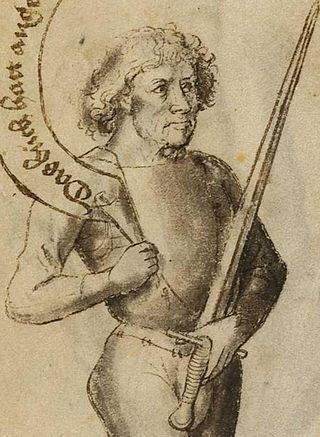
Hans Talhoffer was a German fencing master. His martial lineage is unknown, but his writings make it clear that he had some connection to the tradition of Johannes Liechtenauer, the grand master of a well-known Medieval German school of fencing. Talhoffer was a well-educated man who took interest in astrology, mathematics, onomastics, and the auctoritas and the ratio. He authored at least five fencing manuals during the course of his career, and appears to have made his living teaching, including training people for trial by combat.

Johannes Liechtenauer was a German fencing master who had a great level of influence on the German fencing tradition in the 14th century.

Codex 3227a of the Germanisches Nationalmuseum in Nuremberg is a manuscript of 169 folia, dated to the close of the 14th century. Its text is written in Latin and German. The German portions have been identified as in East Central German dialect.
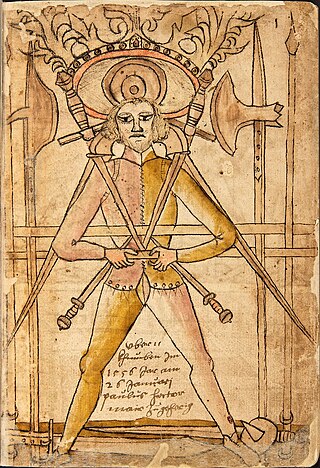
Historical European martial arts (HEMA) are martial arts of European origin, particularly using arts formerly practised, but having since died out or evolved into very different forms.
Martial arts manuals are instructions, with or without illustrations, specifically designed to be learnt from a book. Many books detailing specific techniques of martial arts are often erroneously called manuals but were written as treatises.

The German school of fencing is a system of combat taught in the Holy Roman Empire during the Late Medieval, German Renaissance, and early modern periods. It is described in the contemporary Fechtbücher written at the time. The geographical center of this tradition was in what is now Southern Germany including Augsburg, Frankfurt, and Nuremberg. During the period in which it was taught, it was known as the Kunst des Fechtens, or the "Art of Fighting". The German school of fencing focuses primarily on the use of the two-handed longsword; it also describes the use of many other weapons, including polearms, medieval daggers, messers, and the staff, as well as describing mounted combat and unarmed grappling (ringen).
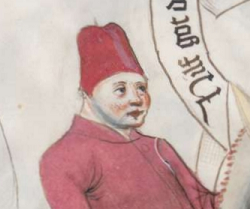
Paulus Kal was a 15th-century German fencing master. According to his own testimony, he was the student of one Hans Stettner, who was in turn an initiate of the tradition of Johannes Liechtenauer. He served as fencing master at three different courts in his career, serving in various military capacities including commanding men in at least three campaigns. Perhaps his most significant legacy is an honor role of deceased masters included in the Bologna and Munich versions of his treatise, which he styled the Society of Liechtenauer. While several of these masters remain unknown, the majority wrote treatises of their own and Kal's list stands as an independent confirmation of their connection to the grand master. Kal's treatise is also interesting in that it represents the first attempt to give pictorial illustrations for parts of Liechtenauer's tradition of fencing.
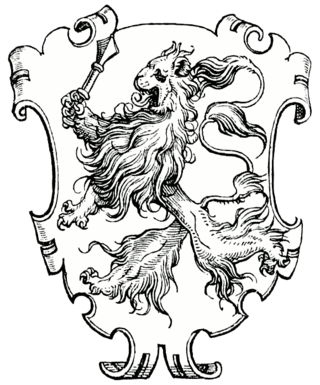
Paulus Hector Mair (1517–1579) was a German civil servant fencing master from Augsburg. He collected Fechtbücher and undertook to compile all knowledge of the art of fencing in a compendium surpassing all earlier books. For this, he engaged the painter Jörg Breu the Younger, as well as two experienced fencers, whom he charged with perfecting the techniques before they were painted. The project was very costly, taking a full four years, and according to Mair, consumed most of his family's income and property. Three versions of his compilation, and one later, less extensive manuscript, have been preserved.

The Brotherhood of Saint Mark was the name of the most important organization of German swordsmen in the 16th century.

The Gladiatoria Group is a series of several 15th-century German manuscripts that share the same art style and cover the same material—various types of armored combat. The texts are contemporary with the tradition of Johannes Liechtenauer, but not directly influenced by it. Gladiatoria is thus one of very few glimpses into the characteristics of a potentially independent German martial tradition.
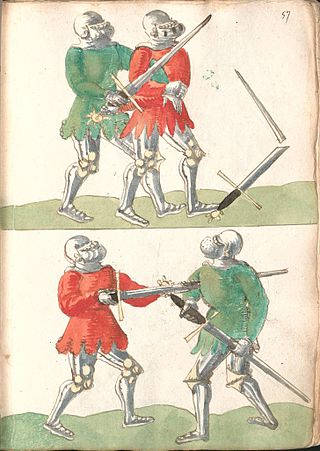
Jörg Wilhalm was an early 16th-century German fencing master, hatmaker, and citizen of Augsburg.
The Cgm 558, or Codex germanicus monacensis is a convolution of two 15th-century manuscripts with a total of 176 folia, bound together in the 16th century. It is kept at the Bavarian library in Munich. The first manuscript contains two chronicles composed by one Otmar Gassow in 1462, one concerned with Zürich, the other with the Toggenburg, and a copy of the 13th century Schwabenspiegel law codex.

The Bavarian State Library in Munich is the central "Landesbibliothek", i. e. the state library of the Free State of Bavaria, the biggest universal and research library in Germany and one of Europe's most important universal libraries. With its collections currently comprising around 10.89 million books, it ranks among the leading research libraries worldwide. The Bayerische Staatsbibliothek furthermore is Europe's second-largest journals library. Furthermore, its historical holdings encompass one of the most important manuscript collections of the world, the largest collection of incunabula worldwide, as well as numerous further important special collections. Its collection of historical prints before 1850 totals almost one million units.

Ringen is the German language term for grappling (wrestling). In the context of the German school of historical European martial arts during the Late Middle Ages and the German Renaissance, Ringen refers to unarmed combat in general, including grappling techniques used as part of swordsmanship.

MS 862 is the number in the nineteenth-century Donaueschingen catalogue of a South German fechtbuch dating to ca. 1500. It is influenced by Paulus Kal and Peter Falkner, and was in turn drawn upon by Jorg Wilhalm (1520s). The manuscript was up for auction at Sotheby's in 2005.
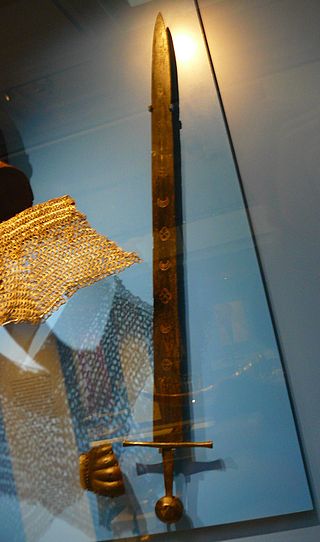
In the European High Middle Ages, the typical sword was a straight, double-edged weapon with a single-handed, cruciform hilt and a blade length of about 70 to 80 centimetres. This type is frequently depicted in period artwork, and numerous examples have been preserved archaeologically.

















